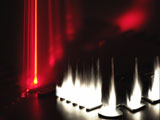Laser processing with highest dynamic
You like to shorten the processing time, the costs and you want to increase your flexibility? The Fraunhofer IWS develops latest technologies in the field of high power remote processing and is, thus, able to multiply the productivity of numerous manufacturing processes.
By the help of modern and very efficient lasers of high brilliance, many different materials can be cut or joined within essential higher speeds. Even highly dynamic cutting- and welding systems with linear direct drives cannot achieve these speeds due to the masses to-be-moved. During a remote processing only the focused laser beam is moved by the help of tilting mirrors of a scanning optics. It is swiftly moved along a workpiece contour from a certain distance. The speed of a laser spot is several meters per second so that even most complex form cuts and weld seams can be finished within seconds.
The large area remote processing with fiber lasers enables working sizes within the square meter range at spot diameters of 500 µm. Compared to conventional large area remote units this processing optics is very compact due to its volume of 0,65 x 0,45 x 0,3 m3 and a weight of 40 kg. It can be run as stand-alone system or it can be mounted to industry robot without problems. The system can be programmed with a CAD/CAM tool. Contours can be generated on a component, intuitionally and graphically assisted, and can be realized in a processing program. The automatically generated program comprises path information as well as technological parameters. This fact makes the system ready for use within the shortest time.
Possible application fields of large area remote optics are the laser cutting and welding processes as well as the short time heat treatment of large component surfaces. Some examples, which have already been transferred into industrial applications, will be presented below.
For small material thicknesses, e.g. metal foils, we can achieve speeds of more than 200 m min-1. In order to improve the manageability of the cutting parts a material composite, consisting of the metal to-be-cut and a sublayer, would be very helpful. This composite has to be soluble. Appling the remote technique only the metallic upper layer is treated, the sublayer remains untouched. The material, to-be-cut, is deposited via an evaporating process. The cut parts and the droppings will be loosened from the sublayer on request. We know the principle from stickers. This procedure is called "kiss-cutting". By applying remote cutting for the "kiss-cutting" process we can achieve apart from high cutting speeds with high flexibility, a minimal heat affected zone with a very good cutting quality. A low sound level and the generating of parts without distortion are further advantages if compared to the stamping procedure.
For complex structures, such as electrical sheets for stator/rotor packages the averaged cutting speed is appr. 20 m min-1, using the cutting systems with linear drives. In the case of the remote technique, contour cuts could be achieved with effective speeds of 10 m min-1. Shielding gas, which usually support the process's effect was largely not needed.
During the remote processing of airbag materials the deflection motion of the laser beam is combined with the continuous transport of the fabric and the periodic oscillation of the beam deflection optics. Webs, 1.5 m of width, are thus cut at web transport speeds of up to 20 m min-1 at a cut accuracy of 0.5 mm. Three systems, installed in industry proved to increase the productivity by 50-90%.
A new production procedure for airbag protective covers has been developed in the form of a continuous production process. Here airbag protective covers are cut from a web in a throughput process. The laser cut of the outline contours of the inner slots and tabs, used for the fastening and the subsequent joining into a tube, happens by remote processing at material transport speeds of several minutes per second.
The remote technique can be efficiently applied in many cases. Stitch welds, frequently used in body-making, may be mentioned here. Most of the part cycle time is used for the feed motion between the short stitch welds. The remote processing shortens this auxiliary process time to a high degree.
More information: Annual Report 2007 p. 35
At the laser fair at Munich (hall C2 stand 350) we will present different remote technologies for the processing of metallic and non-metallic materials. At an exhibit we will demonstrate the numerous possibilities which result in the combination of a quick laser deflection optics with a limited working field and a moving system. All of these are synchronized by innovative software solutions.
Journalists are warmly invited to visit the stand of the Fraunhofer IWS at LASER World of PHOTONICS 2009 in hall C2 stand 350. We also with pleasure book to you an appointment with our experts.
 Fraunhofer Institute for Material and Beam Technology IWS
Fraunhofer Institute for Material and Beam Technology IWS